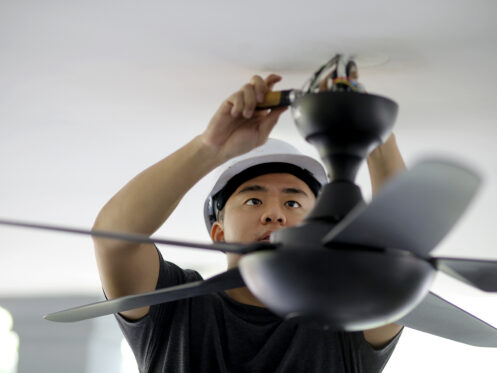Ceiling fans can be a great way to help enhance the efficiency of your HVAC system while lowering your energy bills. If you’re considering investing in a ceiling fan, realizing they’re not all created equal is essential. Use this guide to determine the ideal ceiling fan for each room of your home.
Types of Ceiling Fans
One of the first things you’ll want to consider when purchasing a new ceiling fan is the type you want. Various types of ceiling fans are available, depending on your specific needs.
Standard Ceiling Fan
The most common type of ceiling fan out there will be the standard ceiling fan. These come in various styles and colors depending on your specific needs. They feature four to five blades and have a down rod that allows them to hang from the ceiling. Standard ceiling fans can come with built-in lighting or without, depending on your preferences.
Low-Profile Ceiling Fan
Manufacturers design low-profile ceiling fans to fit in rooms with low ceilings. They may be referred to as flush-mounted fans or hugger fans. These come with the same four to five fan blades. Instead of having a down rod that allows the fan to hang lower, a low-profile fan attaches directly to the mounting bracket. These fans work well in living areas with less than eight-foot and under ceiling heights.
Energy Star Ceiling Fans
Just like there are many different types of Energy Star appliances out there, you can get Energy Star ceiling fans. All ceiling fans with the EPA’s Energy Star classification use 20% to 30% less energy than federal standards require. These particular ceiling fans can be ideal for helping you save more money on your energy bills annually.
Smart Ceiling Fans
You can now get smart ceiling fans, available with or without lighting kits. These allow you to control your ceiling fan remotely via your smartphone or tablet. Smart ceiling fans can also be customized to operate on a set schedule, depending on your individual preferences.
Ceiling Fan Ratings
All ceiling fans are given a specific rating depending on where they can be used. There are three main types of ratings: dry, damp, and wet. Knowing where each one of these fans can be used is important so you can be assured that it will work correctly in the area you choose for it.
Dry
Ceiling fans with a dry rating are intended for use only in dry conditions inside your home. The manufacturer does not design the fan’s materials and electrical components to withstand outdoor elements or excess humidity.
Damp
Ceiling fans with a damp rating are suitable for areas that aren’t exposed directly to rainfall. These areas can include a screened-in porch, covered patio, or similar location. They are also appropriate for bathrooms, kitchens, and laundry rooms.
Wet
Ceiling fans with a wet rating are the most durable. They are built to be directly exposed to the elements, humidity, and even salty ocean breezes. A professional can install them anywhere outdoors.
Ceiling Fan Sizing
Ceiling fans are available in a wide variety of sizes. To ensure that you get the appropriate one, start by measuring the square footage of your room. In general, follow the recommendations listed below when it comes to sizing your new ceiling fan.
- 29 to 36 inches: 75 or less square feet
- 42 to 48 inches: 75 to 175 square feet
- 52 to 56 inches: 175 to 300 square feet
- 60 inches and above: 350 square feet or more
In general, your smaller bathrooms and nooks will need a ceiling fan around 29 to 36 inches in diameter. Alternatively, your bedrooms, dining rooms, and kitchens could likely benefit from a fan that is 42 to 48 inches in diameter. You may find that some of the very large rooms in your home will be better served by multiple fans rather than purchasing one large fan.
Ideal Down Rod Height
The down rod is the pole that hangs from the mounting bracket to the body of your ceiling fan. You’ll find this component on all models except low-profile ceiling fans. Typically, the higher your ceilings are, the longer your download will need to be. You don’t want your fan to be stuck too high up in the ceiling and not able to deliver a nice cold breeze down onto you. You should follow the down rod suggestions listed below:
- Standard: 8 foot ceilings
- 12 inches: 9 foot ceilings
- 18 inches: 10 foot ceilings
- 24 inches: 11 foot ceilings
- 36 inches: 12 foot ceilings
When hanging your ceiling fan, you always want to ensure it’s at least seven feet above floor level. Furthermore, it should be at least one foot away from every wall in the room. This clearance helps to guarantee optimal safety during operation.
Accessories
Like any other appliance in your home, ceiling fans can have various features. Understanding these accessories is critical to ensure that whatever ceiling fan you get has your desired options.
Built-In Lighting
One of the most basic accessory features for a ceiling fan is built-in lighting. These fans can have a single light or multiple lights coming out of the base. More modern ceiling fans will have built-in LED lighting for optimal energy savings and visibility.
Remote Control
Another accessory is a ceiling fan with a remote control. Dual-functioning ceiling fans have a chain that allows you to adjust the speed and rotation direction of the fan. However, if you install one on a high ceiling or in a difficult-to-reach location, a remote can make the fan more straightforward to operate. Even if your fan is wired to a light switch to turn it on and off, you will still need a remote to change its speed and rotation settings.
A Note on Proper Usage
One key reason to purchase a ceiling fan is its ability to help reduce energy costs throughout the year. Ceiling fans are designed to spin in clockwise and counterclockwise directions, and knowing when to use each setting can significantly affect comfort and energy efficiency.
During the summer, set your fan to spin counterclockwise. This direction creates a cooling breeze by pushing air downward, making the room feel cooler without lowering the thermostat. In the winter, switch your fan to spin clockwise at a low speed. This draws cool air upward and forces the warm air that naturally rises to the ceiling to circulate down the walls and back into the living space, helping maintain warmth without overworking your heating system.
Expert Ceiling Fan Installation Service
At Christian Brothers Air Conditioning Plumbing Electrical, we have been serving the residents of Phoenix, AZ and the surrounding areas since 1976. We are experts who can install ceiling fans and help with your home’s other electrical needs. Additionally, we install, maintain, and repair heating and cooling systems. Contact us today to schedule an appointment with one of our experienced team members.










